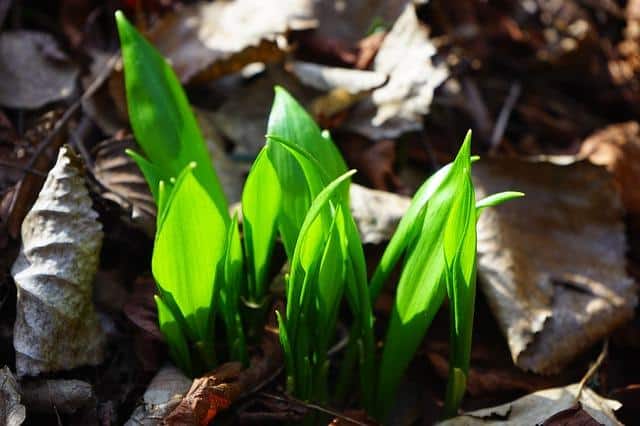Most gardeners are familiar with annual vegetables. These are the one you plant every year, reaping their harvest all season long until the first hard frost comes in the late fall. Many flower gardeners, on the other hand, are familiar with perennial flowers. These are the plants that you plant once and that will continue to return year after year. Lesser known to both vegetable and flower gardeners, though, are the perennial vegetables! After becoming established in your garden or landscape, these plants will continue to produce an edible return, year after year.
Aside from decreasing the amount of work in the garden, there are many reasons to plant perennial vegetables. Once established, perennial vegetables literally take care of themselves. Established perennials are usually more resistant to pests and diseases, making them much more reliant producers. Additionally, perennial vegetables extend the harvest window. Since previously planted perennial vegetables are already established at the beginning of the growing season, they are usually well on their way to harvest when you are just getting around to planting the annual vegetables in the spring.
Perennial vegetables can also serve multiple purposes. Many perennial vegetables are also beautiful, serving as an ornamental plant for your landscape. Some perennial vegetables can act as a hedge or groundcover, while others can provide shade and habitat for insects and pollinators. A few perennial vegetables can actually enhance the health of the soil for themselves and surrounding plants, increasing the health of your garden as a whole.
Need Non-GMO Seeds For Your Garden? Click Here!
While the benefits of perennial vegetable are certainly something to be celebrated, there are a few considerations to keep in mind prior to planting. Some of the perennial vegetables are slow to establish and may take a few years before they produce a significant yield. With that being said, once established, perennial vegetables can quickly spread and take over a garden area. It is important to thoughtfully consider where you are planting perennial vegetables and to maintain a regular harvest schedule. Additionally, perennial vegetables do tend to have a stronger flavor than many of the annual vegetables we usually enjoy. While this may indicate that they pack a nutritional punch, it may take your taste buds awhile to adjust.
The following is a list of some perennial vegetables that will enhance your garden and provide an edible output year after year.
1. Asparagus. Asparagus is probably one of the most well-known perennial vegetables. It takes a few years until it begins producing at its best, but once established you will be enjoying a plethora of fresh shoots every spring. Although it is possible to start asparagus from seed, you can speed up the harvest timeline by planting asparagus crowns.
2. Rhubarb. Although most people know of rhubarb in pie form, it is in fact a perennial vegetable with beautiful leaves (although toxic to humans) and an edible stalk. Like asparagus, rhubarb is best planted from crowns and should be allowed to establish for a few years before harvesting.
3. Horseradish. This is a must-grow vegetable for those who love spice, sushi or mustard greens. The large underground root of the horseradish plant is the source of the strong, spicy flavor that has been known to clear sinuses. If you want to control the spread of this plant, it is important to harvest the entire root in the fall and only replant what you will need for the following year.
4. Sunchokes (Jerusulum Artichokes). Sunchokes are in the same family as sunflowers and are grown for their underground tuber. The plants have yellow flowers that attract beneficial insects to the garden. When cooked, they have a similar taste and consistency to a potato. Sunchokes are vigorous plants, spread quickly, and once planted in a location are difficult to eradicate.
5. Sorrel. Sorrel leaves are tart, lemon-flavored leaves that are delicious in soups and sauces. Sorrel tastes best in early spring and will become bitter in warmer weather. Sorrel grows similar to other garden greens and is not as vigorous of a spreader as other perennial vegetables.
6. Wild garlic. Plant a patch of wild garlic for the first fresh garlic taste of the season. Wild garlic looks and tastes similar to cultivated garlic and loves moist soil and lots of shade.
Seamazing: The Low-Cost Way To Re-mineralize Your Soil
Both the leaves and bulbs are edible with a sharp garlic flavor when raw and a more mild onion flavor when cooked.
7. Scarlet runner beans. While most beans are known to be annuals, if you reside in zone 6 or above scarlet runner beans can be planted as a nitrogen-fixing perennial. As the name suggests, scarlet runner beans will vine and climb up any sunny trellis you provide. They can be eaten fresh like green beans, or allowed to mature and dry to be cooked later in soups and stews.
8. Alpine strawberries. Although not technically a vegetable, alpine strawberries are worth planting as a perennial fruit that also acts as a great groundcover. Similar to cultivated strawberries, alpine strawberries can be planted as crowns, and make a great edible addition to an otherwise ornamental garden. While not as productive as the cultivated variety, once ripe these berries are deliciously sweet garden treats.
9. Hops. While not typically considered a vegetable by many, hops are useful perennials to plant for a number of reasons. The young shoots can be cooked and eaten similar to asparagus, and the cones can be used for beer brewing and as an antibacterial addition to homemade soaps. Hops are a beautiful climber in the garden and exude a delightful smell as well.
What perennial vegetables would you add to this list? Share your thoughts in the section below:
Every Spring, Gardeners Make This Avoidable Mistake — But You Don’t Have To. Read More Here.
 Off The Grid News Better Ideas For Off The Grid Living
Off The Grid News Better Ideas For Off The Grid Living






